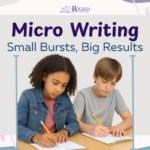Ever had your students annotate a text only to get a half-hearted effort and the inevitable, “Is this enough, Miss?” It’s a common challenge in classrooms, but don’t despair! Here’s how I turned this around with annotation cue cards, and how you can too.
The Challenge: Superficial Annotations
In an 8th-grade class I was working with, students were struggling to annotate texts meaningfully. They were just marking things because the teacher asked them to, without truly engaging with the material. Sound familiar?
The Solution: Annotation Cue Cards
After a coaching session with the teacher, we decided to try using annotation cue cards, inspired by Teaching Literature Rhetorically by Jennifer Fletcher. Here’s how we did it:
Step 1: Identify Key Focus Areas
We started by identifying key aspects of the text that we wanted students to think about. These included:
- Author choices
- Character credibility
- Genre and structure
- Author’s message
- Tone and mood
Step 2: Create Targeted Cue Cards
Next, we created index cards with questions and comments related to these key focus areas. Each card was designed to prompt deeper thinking and discussion. Examples included:
- “Why do you think the author made this choice?”
- “Do you find this character credible? Why or why not?”
- “How does the structure of the text affect its meaning?”
Step 3: Introduce and Model
We introduced the cue cards to the class and modeled their use with a short text. I read the text aloud and demonstrated how to use the cards to interact with it, thinking aloud as I went.
Step 4: Guided Practice
We then provided a new short text and a set of cue cards to the whole class. Together, we read the text and used the cards to guide our discussion, highlighting how different questions led to various insights.
Step 5: Small Group Practice
Students were divided into small groups, each with a new text and set of cards. They worked together to apply the cards to the text, while the teacher and I circulated to provide support and guidance.
Step 6: Independent Practice
For independent practice, students received individual texts and card sets. They worked on their annotations and then shared their thoughts with a partner, fostering peer learning.
Step 7: Creating Their Own Cards
Once students were comfortable using the provided cards, we taught them to create their own. Starting with categories like “Questions,” “Connections,” and “Predictions,” students crafted their cards and shared them with the class.
Step 8: Gradual Release
Over time, we reduced the number of provided cards, encouraging students to internalize the types of questions and comments they’d been practicing. This gradual release fostered independence and critical thinking.
The Result: Engaged, Thoughtful Readers
The impact was immediate. Initially, discussions were superficial, but once our “plants” (students with question or comment cards) shared their thoughts, the conversation shifted. Students began noticing the text in new ways, engaging deeply and thoughtfully.
Implement This Strategy in Your Classroom
Want to try this in your classroom? Here’s a quick guide:
- Identify Key Focus Areas: Determine the aspects of the text you want students to focus on.
- Create Cue Cards: Develop index cards with targeted questions and comments.
- Introduce and Model: Explain the purpose of the cards and model their use with a short text.
- Guide Practice: Use the cards as a class with a new text.
- Group Practice: Have students work in small groups with the cards and a new text.
- Independent Practice: Give students individual texts and cards for independent work.
- Teach Card Creation: Show students how to make their own cue cards.
- Gradual Release: Reduce the number of provided cards over time, fostering independence.
By implementing annotation cue cards, you’re not just asking students to mark up a text. You’re guiding them to become critical, engaged readers who can discuss and analyze texts with confidence and insight. Try it and watch your students transform their approach to reading and discussion.



